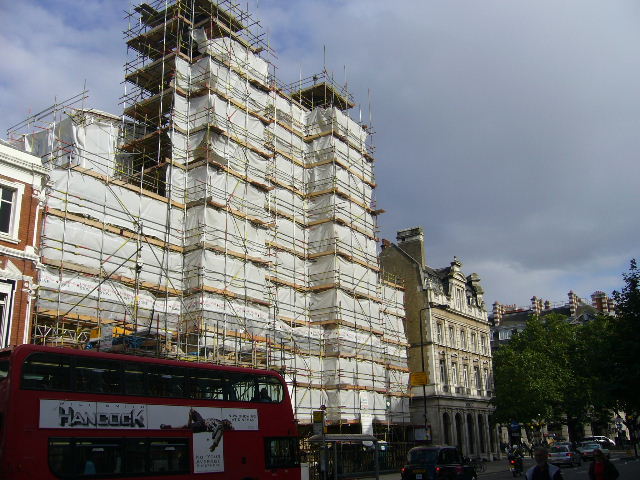- Holy Trinity Sloane Street
Infobox church
name = Holy Trinity Sloane Street
fullname = The Church of the Holy and Undivided Trinity
color =

caption =
landscape =
denomination =Church of England
diocese =Diocese of London
parish =
division =
subdivision =
founded_date =
founder =
architect =John Dando Sedding
style =
constructed_date = 1888-1890
dedicated_date = 1890
closed_date =
demolished_date =
bishop =
priest =
archdeacon =
dean =
provost =
rector =
canon =
prebendary =
curate =
chaplain =
vicar =
deacon =
abbot =
minister =
seniorpastor =
pastor =
address =Sloane Street ,London
country =United Kingdom
phone =020 7730 7270
website =Holy Trinity Sloane Street (The Church of the Holy and Undivided
Trinity withSaint Jude , Upper Chelsea, sometimes known as Holy TrinitySloane Square ) is a London anglicanparish church , built in 1888-90 at the south-eastern side ofSloane Street to a striking Arts & Crafts design by the architectJohn Dando Sedding at the cost of the 5thEarl Cadogan , in whose London estate it lay. It replaced an earlier building only half its size which, at the time of its demolition, was less than sixty years old.History
Holy Trinity was built on a grand scale, suddenly becoming, if not the longest church in the capital then, strangely, the widest, eclipsing
St Paul's Cathedral by four inches. The internal fittings were the work of leading sculptors and designers of the day, includingF. W. Pomeroy , H. H. Armstead,Onslow Ford and Hamo Thorneycroft. In 1891 Sedding died (his memorial can be seen on the north wall in the Lady Chapel) and Henry Wilson took charge of the project to complete the interior decoration of the building to the original design. In part, he failed, for some of the glass was never installed, nor was the important addition of a frieze beneath the high windows even attempted. Some of the internal sculpture/carving is still incomplete. In the 1920s the interior was whitened by F. C. Eden, lightening the character and feel of the building considerably.The church houses an important collection of
stained glass , including an enormous east window by Burne-Jones/Morris; and other windows byWilliam Blake Richmond (including some highly decadent imagery), Powells (the Memorial Chapel) and byChristopher Whall (the incomplete clerestory sequence). The large west window, whichWilliam Morris andEdward Burne-Jones had apparently hoped to complete before moving onto the east window, was never done and the plain glass in it was eventually destroyed by enemy action, although all the other windows survived or were repaired. The interesting project to glaze the west window remains to be realized at some time in the future.The churchmanship at the time of the opening of the new building might have been described as an eclectic High Churchmanship, as the liturgy seems to have been drawn from a number of sources and traditions, although at this distance it is hard to gauge exactly what exactly was done. After a long period of less symbolic worship, notably under the long tenure of Alfred Basil Carver (1945-1980), the building has now returned to a liberal Catholic style of worship.
The church was badly damaged by incendiary bombs in
World War II but was restored more or less to its previous appearance by the early 1960s. In an incredibly odd move, there was then a concerted attempt by the church authorities to close and demolish the building, replacing it with something smaller but this was thwarted by a campaign led byJohn Betjeman and theVictorian Society . The building now houses a thriving congregation built during the ten years under the incumbency of Michael Eric Marshall (1997-2007), the former Bishop of Woolwich. It would seem that the connenction with the world of the fine arts not represented in the building and its fittings but in the sponsorship and encouragement of artists and musicians old and young will continue under the rectorship of the Rev. Rob Gillion, himself trained as an actor, and due to take charge as Rector late in 2008.The Organ
Holy Trinity had a reputation for
anglican church music from the early days, for Sedding was himself an organist, providing in the ground plan of the building an unusually large chamber for the famous four-manualJ. W. Walker & Sons Ltd organ to occupy at the north-east corner.The Organists
Notable organists have included
Edwin Lemare (1892-5), SirWalter Alcock (1895-1902) and H. L. Balfour (1902-42), all of whom were leading men in their field; and the tradition continues to this day. The composerJohn Ireland was Alcock's assistant; he had hoped to be promoted when the latter left in 1902 but was regarded as too young to take over, a decision later viewed as an unfortunate mistake.Players of St Peter
The
Players of St Peter , a company devoted to performing medievalmystery play s were based here from 1988 to 1997. [ [http://www.rhaworth.myby.co.uk/pofstp/proglist.htm Players of St Peter cast lists] ]Holy Trinity today
Recently, Holy Trinity Sloane Street has sponsored international Christian links through a network of Friends. It is host church for the Trinity Foundation for Christianity and Culture (TFCC), a teaching and outreach organization dedicated in part to the increase of interfaith understanding and respect, with branches in other parts of the world, notably in the Middle East and North America.
As a local parish church, Holy Trinity now offers a selection of liturgical worship and community events and is a concert venue. Uncluttered by static pews, the vast nave provides flexible space for concerts and events, the focus of some of which mirrors and re-expresses the artistic climate surrounding its first two decades. An arts and crafts guild was established by Michael Marshall early in his incumbency; more recently, an annual summer festival, the Chelsea Schubert Festival, has appeared, supplemented by concerts and recitals during the rest of the year.
External links
* [http://www.holytrinitysloanesquare.co.uk Holy Trinity official website]
* [http://tfccinternational.com TFCC]
* [http://www.chelseaschubertfest.co.uk Chelsea Schubert Festival website]
Wikimedia Foundation. 2010.
